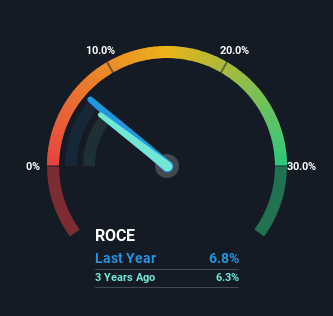- China
- /
- Construction
- /
- SHSE:601611
China Nuclear Engineering (SHSE:601611) Could Be Struggling To Allocate Capital

What are the early trends we should look for to identify a stock that could multiply in value over the long term? In a perfect world, we'd like to see a company investing more capital into its business and ideally the returns earned from that capital are also increasing. Basically this means that a company has profitable initiatives that it can continue to reinvest in, which is a trait of a compounding machine. Although, when we looked at China Nuclear Engineering (SHSE:601611), it didn't seem to tick all of these boxes.
Understanding Return On Capital Employed (ROCE)
For those that aren't sure what ROCE is, it measures the amount of pre-tax profits a company can generate from the capital employed in its business. Analysts use this formula to calculate it for China Nuclear Engineering:
Return on Capital Employed = Earnings Before Interest and Tax (EBIT) ÷ (Total Assets - Current Liabilities)
0.068 = CN¥5.8b ÷ (CN¥215b - CN¥131b) (Based on the trailing twelve months to September 2023).
Thus, China Nuclear Engineering has an ROCE of 6.8%. On its own that's a low return on capital but it's in line with the industry's average returns of 6.8%.
See our latest analysis for China Nuclear Engineering

In the above chart we have measured China Nuclear Engineering's prior ROCE against its prior performance, but the future is arguably more important. If you'd like, you can check out the forecasts from the analysts covering China Nuclear Engineering for free.
What Does the ROCE Trend For China Nuclear Engineering Tell Us?
Unfortunately, the trend isn't great with ROCE falling from 10% five years ago, while capital employed has grown 244%. However, some of the increase in capital employed could be attributed to the recent capital raising that's been completed prior to their latest reporting period, so keep that in mind when looking at the ROCE decrease. It's unlikely that all of the funds raised have been put to work yet, so as a consequence China Nuclear Engineering might not have received a full period of earnings contribution from it.
On a related note, China Nuclear Engineering has decreased its current liabilities to 61% of total assets. So we could link some of this to the decrease in ROCE. Effectively this means their suppliers or short-term creditors are funding less of the business, which reduces some elements of risk. Some would claim this reduces the business' efficiency at generating ROCE since it is now funding more of the operations with its own money. Keep in mind 61% is still pretty high, so those risks are still somewhat prevalent.
Our Take On China Nuclear Engineering's ROCE
To conclude, we've found that China Nuclear Engineering is reinvesting in the business, but returns have been falling. Additionally, the stock's total return to shareholders over the last five years has been flat, which isn't too surprising. All in all, the inherent trends aren't typical of multi-baggers, so if that's what you're after, we think you might have more luck elsewhere.
If you want to know some of the risks facing China Nuclear Engineering we've found 2 warning signs (1 is a bit unpleasant!) that you should be aware of before investing here.
If you want to search for solid companies with great earnings, check out this free list of companies with good balance sheets and impressive returns on equity.
New: AI Stock Screener & Alerts
Our new AI Stock Screener scans the market every day to uncover opportunities.
• Dividend Powerhouses (3%+ Yield)
• Undervalued Small Caps with Insider Buying
• High growth Tech and AI Companies
Or build your own from over 50 metrics.
Have feedback on this article? Concerned about the content? Get in touch with us directly. Alternatively, email editorial-team (at) simplywallst.com.
This article by Simply Wall St is general in nature. We provide commentary based on historical data and analyst forecasts only using an unbiased methodology and our articles are not intended to be financial advice. It does not constitute a recommendation to buy or sell any stock, and does not take account of your objectives, or your financial situation. We aim to bring you long-term focused analysis driven by fundamental data. Note that our analysis may not factor in the latest price-sensitive company announcements or qualitative material. Simply Wall St has no position in any stocks mentioned.
About SHSE:601611
China Nuclear Engineering
Engages in the nuclear power, industrial, and civil engineering businesses in China.
Proven track record with adequate balance sheet.
Market Insights
Community Narratives



